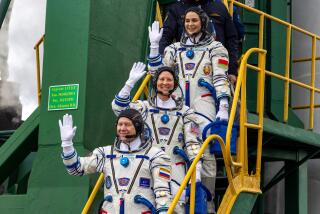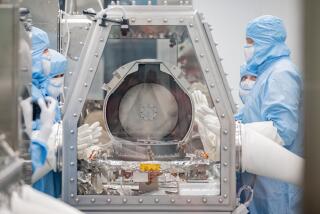NASA astronauts open SpaceX capsule hatch and begin unloading cargo
Less than 24 hours after a historic docking, astronauts aboard the International Space Station clambered into SpaceX’s unmanned Dragon spacecraft and began unloading supplies that were packed inside.
Wearing oxygen masks as a precaution, the astronauts opened the hatch, slid the door open, and took delivery of the 1,014 pounds of food, water and clothing aboard Dragon.
“Like the smell of a brand new car,” said NASA astronaut Don Pettit, after going inside.
Live coverage of the hatch opening, which included some of the first video footage from inside the cone-shaped Dragon, started Saturday shortly before 3 a.m PDT on the Hawthorne company’s website and NASA TV.
Delivering cargo wasn’t SpaceX’s key mission -- the space station is well-provisioned. The main purpose was to demonstrate that the Dragon space capsule could rendezvous with the $100-billion orbiting outpost and link up with the space station’s onboard computers.
Those goals were achieved when the Dragon docked with the space station at 9:02 a.m. PDT on Friday. It marked the first time a privately built and operated space capsule had done so.
Not only was it a milestone for SpaceX, it could also indicate a potential seismic shift for U.S. spaceflight, which for more than half a century has been the province of governments and large, entrenched aerospace firms.
SpaceX, offically named Space Exploration Technologies Corp., built its Dragon capsule and the Falcon 9 rocket that lifted it into orbit on its own. By contrast, the overall design of NASA’s previous spacecraft vehicles and their missions were tightly controlled by the government and contracted to aerospace giants.
SpaceX, with about 1,800 employees, has received nearly $400 million in seed money from NASA and has a $1.6-billion contract to haul cargo in 12 flights to the space station for the agency.
Now that the U.S. fleet of space shuttles has been retired, NASA’s plan is to outsource space station missions to privately funded companies. If NASA deems the current test mission successful, SpaceX will begin fulfilling the cargo-carrying contract later this year.
In the current mission, which began early Tuesday morning with a launch from Cape Canaveral, Fla., the Dragon is slated to stay at the space station until Thursday.
Once released from the space station, the craft should make its way back to Earth and deploy parachutes to slow its descent after entering the atmosphere.
It’s set to splash down Thursday in the Pacific Ocean hundreds of miles west of Southern California.
RELATED:
SpaceX: A new frontier for space travel
NASA hails SpaceX launch as ‘a new era’ for spaceflight
SpaceX capsule docks at International Space Station
Twitter.com/@wjhenn







